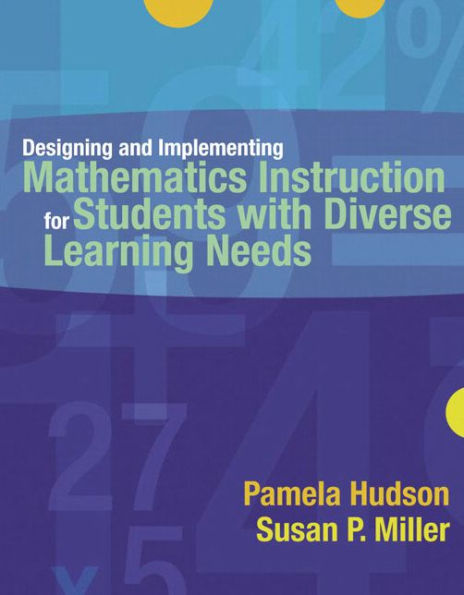Table of Contents
I. 1. An Overview of Mathematics Curriculum and Instruction.
A. Introduction.
B. Curriculum Factors.
1. Following a Hierarchy and Sequence of Skills.
2. Prioritizing Essential Skills.
3. Creating a Meaningful Context.
C. Instructional Domains.
1. Conceptual Understanding.
2. Declarative Knowledge.
3. Procedural Knowledge.
4. Application.
D. Explicit Teaching Cycle & Principles.
1. Curriculum-Based Assessment.
2. Planning.
3. Advance Organizer.
a. Review.
(1) Planning the review.
(2) Conducting the review.
b. State lesson objective and link.
c. Develop relevance.
4. Demonstration ("I do").
a. Model thinking and action.
b. Maximize student engagement.
c. Monitor student understanding.
5. Guided Practice ("We do").
a. Vary levels of support.
b. Monitoring student performance.
6. Independent Practice ("You Do").
a. Planning the practice format.
b. Providing distributive practice.
c. Monitoring student performance.
7. Maintenance.
8. Monitoring Student Acquisition of New Material.
9. Teaching Culturally and Linguistically Diverse Learners.
2. Curriculum-Based Assessment and Planning.
A. Introduction.
B. Curriculum-based Assessment.
1. Types of Curriculum-based Assessments.
2. Student Performance Measures and Recording Systems.
a. Percentage.
b. Rate.
c. Error analysis.
3. Data-based Decision Making.
a. Survey CBA.
b. Untimed focused CBA.
c. Probes.
4. Steps for Developing and Administering CBA.
5. Survey CBA Case #1.
6. Untimed Focused CBA Case #2.
7. Developing and Administering a Probe Case #3.
.
C. Planning Instruction.
1. Identify Math Curriculum and Write Goals and Objectives.
2. Form Instructional Groups.
3. Develop Lesson Plans.
a. Target one concept, skill, or set of facts for instruction.
b. Design the lesson.
c. Instructional alignment.
4. Adapting the General Education Textbook Lessons.
3. Developing Conceptual Understanding.
A. Introduction.
B. Characteristics of Instruction Designed to Promote Conceptual Understanding.
C. Rationale for Promoting Conceptual Understanding.
D. Planning Guidelines.
1. Make Appropriate Decisions Related to Manipulative Devices.
2. Select Pictures and Visual Displays.
3. Plan for Integration of Written Symbols.
4. Plan for Real-World Application.
E. Implementation Guidelines.
1. Use Concrete-Representational-Abstract Approach.
2. Use Explicit Lesson Sequence.
4. Teaching Procedural Strategies.
A. Introduction.
B. Rationale for Teaching Procedural Strategies.
C. Characteristics of a Procedural Strategy.
D. Guidelines for Planning Instruction that Teaches a Procedural Strategy.
1. Identify the prerequisites.
2. Write a procedural strategy.
3. Select a complete set of problem examples.
(a) Aligning all problem examples.
(b) Providing a full range of examples.
(c) Including discrimination problems.
4. Guidelines for Implementing Procedural Strategy Instruction.
(a) Provide an advance organizer.
(b) Provide demonstration ("I do").
(1) Model thinking and action.
(2) Maximize student engagement.
(3) Monitoring student understanding.
(c) Provide guided practice ("We do").
(1) Vary levels of support.
(2) Monitoring student understanding.
(d) Provide independent practice (""You do").
(1) Monitoring student performance.
(2) Collecting data.
5. Developing Declarative Knowledge.
A. Introduction.
B. Characteristics of Instruction Designed to Develop Declarative Knowledge.
C. Rationale for Developing Declarative Knowledge.
1. The Importance of Declarative Knowledge with Basic Math Facts.
2. The Importance of Declarative Knowledge with Number Sense.
3. The Importance of Declarative Knowledge with Functional Skills.
D. Instructional Practices to Develop Declarative Knowledge.
1. Constant Time Delay.
2. Prompt Fading Procedure.
3. 1-Minute Timings.
(a) Establish rate goals using tool skills already in students' declarative knowledge network.
(b) Establish goals using the adult/student proportional formula.
(c) Establish goals using local norms.
(d) Establish goals using guidelines reported in the literature.
(e) Gather and/or develop needed materials.
(f) Administer timings in a positive, structured manner.
(g) Provide feedback.
4. Instructional Games.
5. Three-Step Labeling Procedure.
6. Verbal Rehearsal.
(a) Group rehearsal.
(b) Peer-assisted and individual rehearsal.
(c) Rapid-fire verbal rehearsal.
7. Computer-Based Instruction.
6. Enhancing Problem Solving Abilities.
A. Rationale for Enhancing Problem Solving Abilities.
1. Mathematical Problem Solving in the Workplace.
2. Mathematical Problem Solving in Daily Living.
3. Mathematical Problem Solving in Leisure Activities.
4. Problem Solving Performance of Students with Disabilities.
B. Guidelines for Planning Problem Solving Instruction.
1. Develop Appropriate Word Problems.
2. Integrate Authentic Problem Solving Experiences.
C. Guidelines for Implementing Problem Solving Instruction.
1. Word Problem Instruction.
2. Anchored Instruction.
3. Functional Application of Life Skills.
II.
7. Number Readiness.
A. Scope and Sequence Chart.
B. Counting.
C. Reading and Writing Numbers.
D. Relationships Among Whole Numbers.
E. Place Value.
F. Estimation.
8. Addition and Subtraction of Whole Numbers.
A. Scope and Sequence Chart.
B. Basic Facts.
C. Advanced Operations.
9. Multiplication and Division of Whole Numbers.
A. Scope and Sequence Chart.
B. Basic Facts.
C. Advanced Operations.
10. Rationale Numbers.
A. Scope and Sequence Chart.






